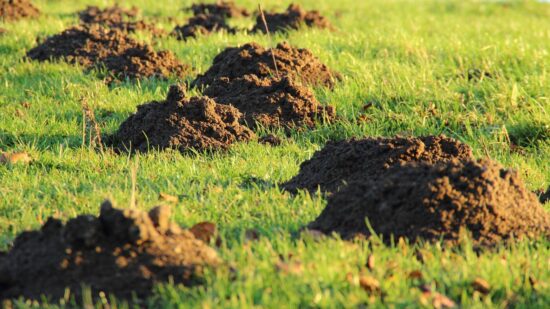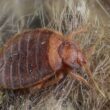Molehills popping up overnight in your yard can be incredibly frustrating. When traditional methods seem too expensive or complicated, many homeowners turn to boric acid as a DIY solution for how to get rid of moles in their yard.
This white powder has been used for pest control for years, and some people report success with mole problems. However, the scientific evidence for getting rid of moles in your yard with boric acid is pretty limited.
Important Safety Note: Boric acid can harm your lawn, contaminate soil, and pose risks to kids and pets. Most of these methods lack strong scientific backing, so proceed carefully.
This guide covers ways to get rid of moles in your yard, including what you’ll need and honest info about whether they actually work.
What You Need to Know About Boric Acid and Moles
Boric acid is a mineral that comes from boron, an element found naturally in rocks and soil. It works as a stomach poison for many insects, but moles are mammals with very different eating habits.
Moles spend most of their time underground, creating tunnel systems while hunting for earthworms, grubs, and other soil creatures. They have an amazing sense of smell and touch, which helps them navigate in complete darkness.
The tricky part about using boric acid for moles is that there isn’t much scientific research proving it works. Most university experts recommend other methods with better track records. Still, some homeowners report success, so let’s look at what they’re doing.
1. Direct Tunnel Flooding Method
This is probably the most common way people try getting rid of moles in your yard with boric acid. The idea is to flood their tunnels with a boric acid solution, making the area unpleasant for them to live in.
Materials Needed:
- Boric acid powder (available at hardware stores)
- Garden hose or large watering can
- Protective gloves and safety goggles
- Face mask to avoid breathing powder
- Measuring cup
Step by Step Process:
Start by finding active mole tunnels in your yard. Look for raised ridges in the grass that feel soft when you step on them. These are the highways moles use most often.
Mix about 1 tablespoon of boric acid with 1 gallon of water. Stir until the powder dissolves completely. The solution should be clear with no visible particles floating around.
Put on your protective gear before handling the mixture. Safety should always come first when working with any chemical, even natural ones.
Use your hose or watering can to flood the active tunnels with the boric acid solution. Pour slowly and let the liquid soak deep into the tunnel system. You want to saturate the area where moles travel most.
Check the tunnels every few days. If you see new activity, repeat the process. Some people do this weekly for a month to see if it makes a difference.
Safety Warnings:
Boric acid can damage grass and plants if you use too much. Even small amounts can kill sensitive plants, so be careful around flower beds and vegetable gardens.
The solution can also soak into groundwater, which isn’t great for the environment. Always wear protective gear to avoid skin contact and breathing the powder.
Effectiveness Reality Check:
Here’s the honest truth: this method often doesn’t work very well. Moles can simply dig deeper or create new tunnels to avoid treated areas. The solution also gets diluted quickly in soil, reducing any potential effect.
2. Boric Acid Bait Station Method
Some homeowners try to trick moles into eating boric acid by mixing it with foods they naturally enjoy. This approach attempts to use the mole’s own feeding behavior against them.
Materials Needed:
- Boric acid powder
- Fresh earthworms or grubs (from a bait shop)
- Small plastic containers with lids
- Drill with small bits
- Waterproof markers
- Disposable gloves
Step by Step Process:
Buy some earthworms or grubs from a fishing supply store. These are the foods moles love most, so they make the best bait options.
Put on gloves and lightly dust the worms with a small amount of boric acid powder. Don’t use too much or the smell might scare moles away. Just a light coating should do the trick.
Drill several small holes in plastic containers, big enough for moles to enter but small enough to keep larger animals out. This protects the bait from rain and other creatures.
Place the bait containers near active tunnel openings. Look for fresh molehills or areas where you’ve seen recent digging activity. Mark each location so you can check them later.
Check your bait stations every 2-3 days. Replace any old or moldy bait with fresh worms. Keep a log of which stations show activity.
Important Limitations:
Moles have plenty of natural food sources in most yards, so they might ignore your bait completely. They’re also very cautious about anything that smells different or unusual.
The biggest safety concern is keeping these bait stations away from pets and children. Dogs especially love to dig up and eat things like this, which could make them very sick.
Why This Often Fails:
Moles are picky eaters with sensitive noses. If the boric acid changes how the bait smells, they’ll probably avoid it completely. Plus, your yard likely has tons of natural earthworms they can catch easily.
3. Soil Amendment Approach
This method treats boric acid like a fertilizer, spreading it across your lawn to make the entire area less appealing to moles. Some people mix it with regular fertilizer to hide the application.
Materials Needed:
- Boric acid or borax powder
- Broadcast spreader or handheld spreader
- Garden rake
- Sprinkler or irrigation system
- Measuring scale
Step by Step Process:
Calculate how much boric acid to use based on your lawn size. Most people try about 1 pound per 1000 square feet, but this is just a guess since there’s no official recommendation.
Load your spreader with the boric acid powder. If you’re mixing it with fertilizer, blend them thoroughly first. Make sure the mixture is even throughout.
Walk your spreader across the lawn in overlapping passes, just like you would with regular fertilizer. Try to get even coverage without missing spots or doubling up in areas.
Rake the treated area lightly to work the powder into the top layer of soil. This helps it stay in place and reduces the chance of it blowing around.
Water the lawn thoroughly to dissolve the boric acid into the soil. Use at least an inch of water to make sure it soaks down to where moles might encounter it.
Critical Warnings:
This is actually the riskiest method on this list. Boric acid can easily kill grass and other plants, especially if you use too much or apply it unevenly.
The powder can also wash into storm drains, streams, and groundwater. Many areas have rules about what chemicals you can put on your lawn, so check local regulations first.
Why This Method Is NOT Recommended:
Even small amounts of extra boron can damage or kill grass. Most soil already has enough boron for plants, so adding more often causes problems rather than solving them.
You’ll likely end up with dead patches in your lawn and still have moles. The cost of repairing grass damage usually costs way more than hiring a professional pest control service.
4. Perimeter Treatment Method
This approach focuses on creating a barrier around your property to keep moles from entering in the first place. Think of it like drawing an invisible line that moles won’t want to cross.
Materials Needed:
- Liquid boric acid solution
- Garden sprayer or pump sprayer
- Measuring tools
- String or stakes to mark treatment areas
- Protective clothing
Step by Step Process:
Walk around your property and identify likely entry points for moles. Look for areas where your lawn meets wooded areas, neighbor’s yards, or open fields.
Mix a stronger boric acid solution for this method. Try 2-3 tablespoons per gallon of water. The idea is to create a more noticeable barrier.
Use stakes and string to mark a treatment zone about 3 feet wide around your property’s edge. This helps you apply the solution evenly and avoid missing spots.
Spray the marked perimeter area thoroughly with your boric acid solution. Make sure to overlap your passes so there are no gaps in coverage.
Reapply the treatment after heavy rains or every 2 weeks during active mole season. The solution needs to stay in the soil to maintain any potential effect.
Effectiveness Issues:
Moles are amazing diggers that can easily tunnel under any surface treatment. They often travel 6-12 inches underground, which is deeper than most sprayed solutions reach.
Rain and irrigation quickly wash away surface treatments, so you’ll need to reapply frequently. This gets expensive and time consuming without much benefit.
Better Barrier Alternatives:
Physical barriers work much better than chemical ones. Underground fencing that goes 2 feet deep actually stops moles, while surface sprays rarely do anything useful.
5. Molehill Direct Application Method
Many people see molehills and think that’s where moles live, so they put boric acid directly on these mounds. Unfortunately, this shows a misunderstanding of how moles actually use their tunnel systems.
Materials Needed:
- Boric acid powder
- Small shovel or hand trowel
- Watering can with fine nozzle
- Work gloves
- Kneepads (optional but helpful)
Step by Step Process:
Find fresh molehills in your yard. These look like small volcanoes of dirt that appear overnight. The soil is usually darker and more crumbly than the surrounding area.
Use your trowel to create a small depression in the center of each molehill. Make it about 2 inches deep and wide enough to hold a tablespoon of powder.
Sprinkle boric acid powder directly into each depression. Use about 1 tablespoon per molehill, but don’t go overboard with the amount.
Cover the powder lightly with some of the loose soil from the mound. This helps keep it in place and prevents it from blowing away in the wind.
Water each treated molehill gently with your watering can. Use just enough water to moisten the soil without washing the boric acid away.
Why This Doesn’t Work:
Here’s the key fact most people don’t know: molehills are basically mole garbage dumps. They’re created when moles push excess dirt up from deep tunnels, but moles rarely return to these spots.
Moles spend their time in the tunnel system, not in the molehills. Treating the mounds is like trying to catch fish by putting bait on the shore instead of in the water.
What You Should Do Instead:
Focus on active tunnels rather than molehills. Look for raised ridges in your grass that feel soft when you step on them. These are the areas where moles actually travel.
6. Granular Slow Release Method
This method mixes boric acid with sand or soil to create granules that release the chemical slowly over time. The theory is that this provides longer lasting coverage than liquid applications.
Materials Needed:
- Boric acid powder
- Clean sand or dry soil
- Large mixing bucket
- Broadcast spreader
- Garden rake
- Measuring cups
Step by Step Process:
Mix 1 part boric acid with 4 parts clean sand in a large bucket. Stir thoroughly until the powder coats all the sand particles evenly. The mixture should look uniform throughout.
Load the mixture into your broadcast spreader just like you would with grass seed or fertilizer. Adjust the spreader setting to medium for even distribution.
Apply the granular mixture to areas with active mole tunnels. Focus on the raised ridges and areas where you’ve seen recent digging activity.
Rake the treated areas lightly to work the granules into the top inch of soil. This helps them stay in place during rain and watering.
Water the area with a light sprinkle to activate the boric acid. Don’t flood it, just enough moisture to start the slow release process.
Problems with This Approach:
Getting the right concentration is really hard with homemade granules. Too little boric acid means no effect, while too much can damage your lawn in patches.
The granules tend to clump together when they get wet, creating uneven distribution. Some areas get too much chemical while others get none at all.
Risk of Over Application:
It’s easy to accidentally put down too much of this mixture, especially in areas where you overlap your spreader passes. Even small amounts of extra boric acid can create dead spots in grass.
7. Combination Treatment Method
Some determined homeowners try multiple boric acid methods at once, thinking that more approaches mean better results. This usually involves tunnel flooding plus bait stations plus perimeter treatments all happening together.
Materials Needed:
- All materials from previous methods
- Organization system to track different treatments
- Calendar or notebook for scheduling
- Extra protective equipment
- More time and money than single methods
Step by Step Process:
Start with the tunnel flooding method in areas with the most mole activity. Apply boric acid solution to active tunnels twice per week.
Set up bait stations around the perimeter of treated tunnel areas. Check and refresh these every few days to keep bait fresh.
Apply perimeter treatments around your entire property boundary. Reapply after rain or every two weeks during peak mole season.
Keep detailed records of where you’ve applied each treatment and when. This helps you avoid over treating areas and track what might be working.
Monitor all treated areas daily for new mole activity. Look for fresh tunnels, new molehills, or disturbed bait stations.
Why Combination Treatments Often Fail:
Using multiple ineffective methods together doesn’t create one effective solution. If boric acid doesn’t work well for moles individually, combining approaches won’t fix the basic problem.
You’re also multiplying the environmental risks and costs without getting better results. The time and money spent on combination treatments could buy professional services that actually work.
Increased Environmental Impact:
Multiple applications mean more boric acid in your soil and potentially in groundwater. This increases the risk of plant damage and environmental contamination.


